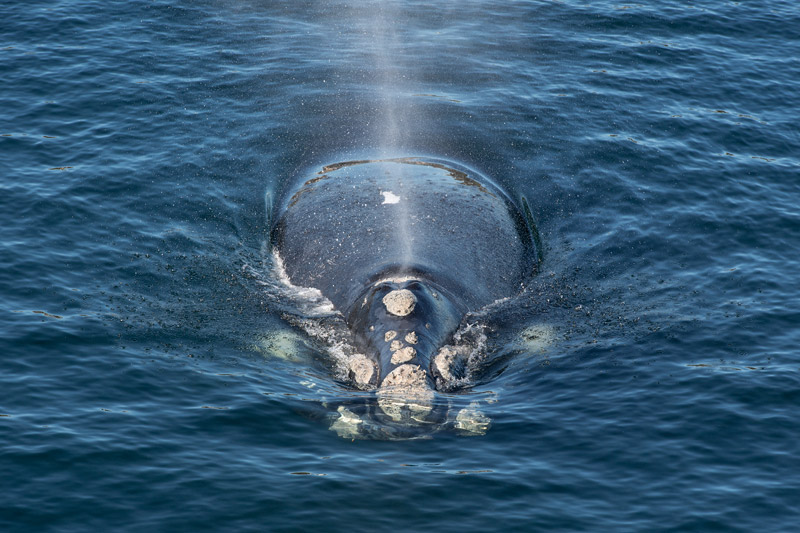
The Southern Right Whale is the only Right Whale species found in the southern hemisphere.
Right whales are slow swimmers, curious and love exploring shallow waters in bays and estuaries. They are also ‘fat’ with a much higher ratio of blubber than other whale species which means they float when dead. The unfortunate consequences of this was that they were easy targets for the early whalers with the mothers and calves first to go. They quickly became known as the ‘right’ whale to catch.
Right whales are easily distinguished from other whales by the white skin callosities on their head, a broad back without a dorsal fin, and a long arching mouth that begins above the eye. Their skin is a very dark grey or black and occasionally they have some white patches on the stomachs. The distinctive Callosities patches of white skin on their heads are unique to each animal allowing individuals to be identified.
Whaling decimated the world wide Right whales populations and numbers had so significantly collapsed by the 1930’s that they were officially protected. Unfortunately illegal whaling continued well into the 1970’s. Given their slow reproduction rates the Right whales are struggling to recover particularly in the Northern Hemisphere.
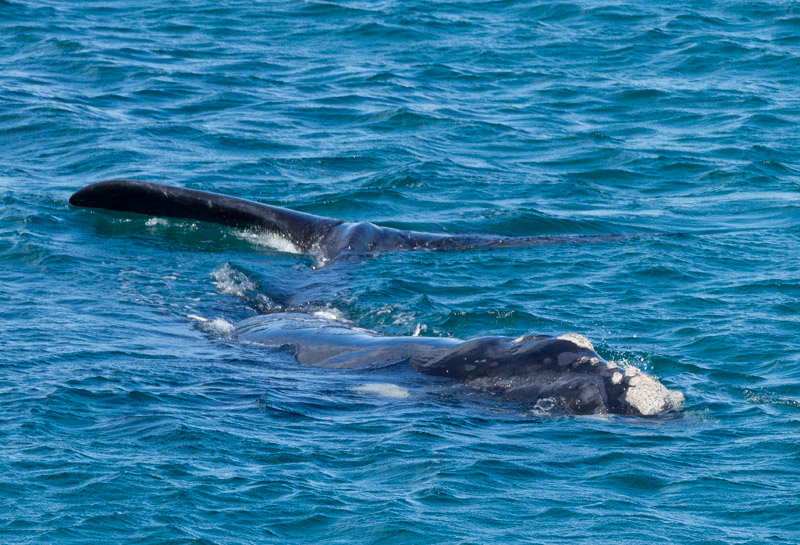
Common Name: Southern Right Whale
Other Names: Right Whale
Scientific Name: Eubalaena australis
Conservation Status: Endangered
Length: New-born calf 5 to 6 metres, Adult Females 11 to 15 metres, Adult Males 11 to 18 metres.
Weight: Birth weight is about 2 tonnes. Adults weigh up to 80 tonnes.
Gestation: 11 to 12 months
Weaning Age: 11 to 12 months
Calving Interval: 3 to 4 years
Physical Maturity: unknown
Sexual Maturity Age: 10 years
Lifespan: 70+ years
Mating Season: June to August
Calving Season: June to August
Cruising Speed: 3km/h
Protected Since: 1935
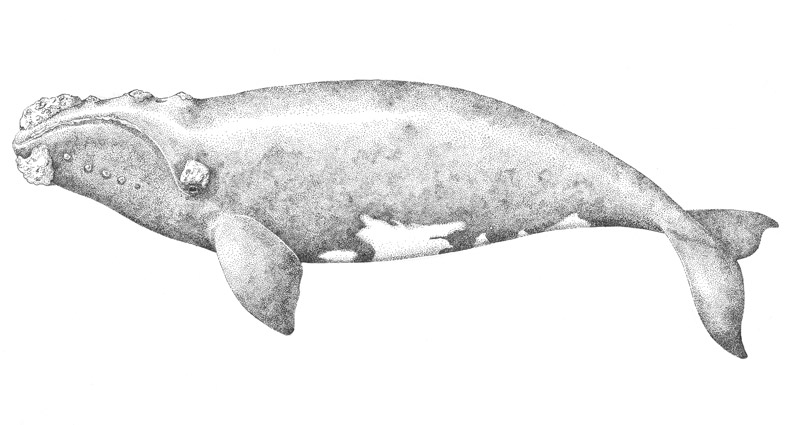
Field Identification
– Dark skin with irregular white patches on the throat and belly.
– Rotund body.
– Callosities (white lumps) on large head, head about a quarter of their body length.
– V Shaped blow.
– Two blowholes, very high blow/spout.
– Long & broad pectoral fins that are rectangular in shape.
– No dorsal fin on their back.
– Tail flukes raised when diving, broad flukes.
– Slow & deliberate swimmer.
– Highly acrobatic, frequently lobtails and spyhops.
– Very curious – may approach boats.
– Normally in small groups.
– Baleen instead of teeth, strongly arched mouth line, large dark chin.
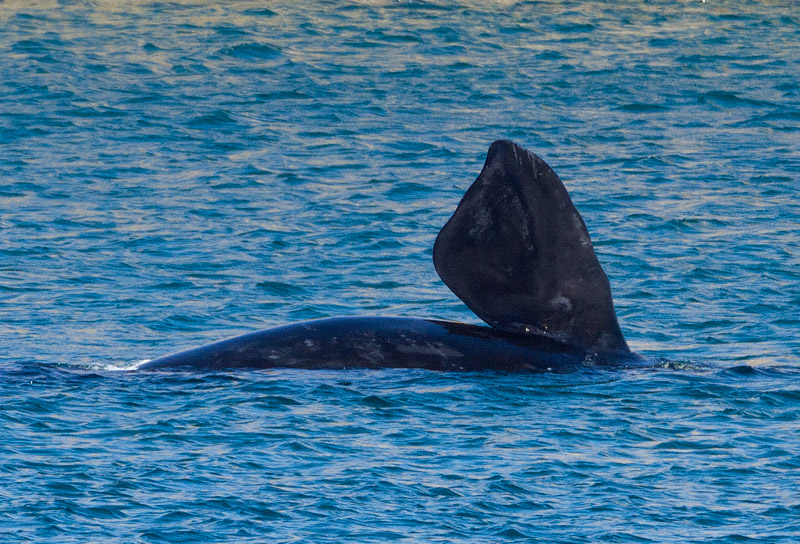
Taxonomy
The Right Whales, including the Bowhead were first classified in the genus Balaena by Carl Linnaeus in 1758 and all considered to be a single species. Over time they have been recategorised many times into one single species then broken up into individual species.
As late as 2000 and based on the study of DNA samples from each of the whale populations it was demonstrates that the northern and southern populations of Right Whale have not interbred for between 3 million and 12 million years, confirming that there are in fact three distinct species, the North Atlantic Right Whale (Eubalaena glacialis), the North Pacific Right Whale (Eubalaena japonica) and the Southern Right Whale (Eubalaena australis). The genetic differences showed that the North Pacific Right Whale is more closely related to the Southern Right Whale than to the North Atlantic Right Whale.
It is believed that the right whale population was split when North and South America joined physically separating them. As temperatures rose at the equator the Pacific Right Whales were split and prevented from interbreeding.
It is believed that the right whale populations first split because of the joining of North and South America. The rising temperatures at the equator then created a second split, into the northern and southern groups, preventing them from interbreeding.
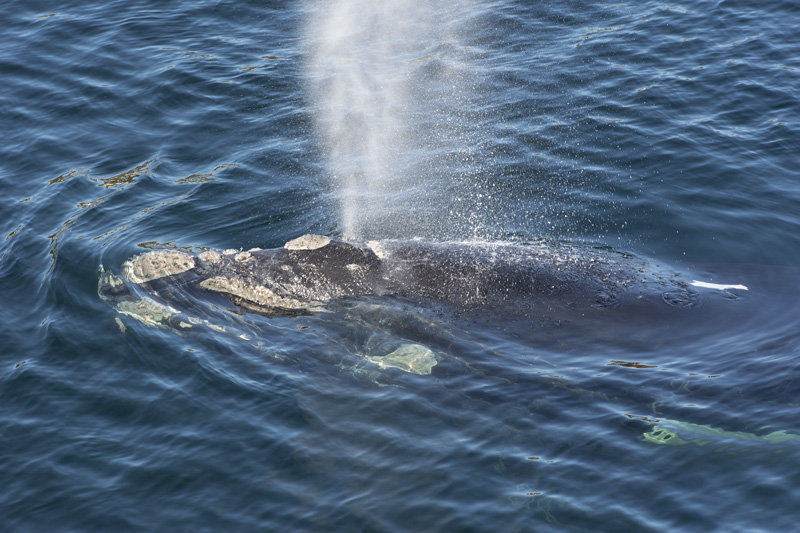
Description
The Southern Right Whale is a large baleen whale similar in length to a Humpback Whale but much heavier with a less streamlined body.
At birth Southern Right Whales are about 5+ metres and between one and two tonnes in weight. They grow to a maximum length of 17.5 metres and 80 tonnes in weight. Adult females are often slightly larger than males. It is believed that they become sexually mature once they reach over 13 metres in length and physical maturity once they reach16 metres in length. Their age at physical maturity is unknown.
Southern Right Whales have a portly body shape. Although they are similar in length to Humpbacks they can be up to 30 tonnes heavier. Their pectoral fins are short, stubby and paddle like with smooth trailing edge. They do not have a dorsal fin. The vast majority are an overall black in colour, often with white markings of varying size and shape on their undersides. A small percentage have a grey mottle colouring. They have thick blubber layers of up to 24cm thickness for adult whales.
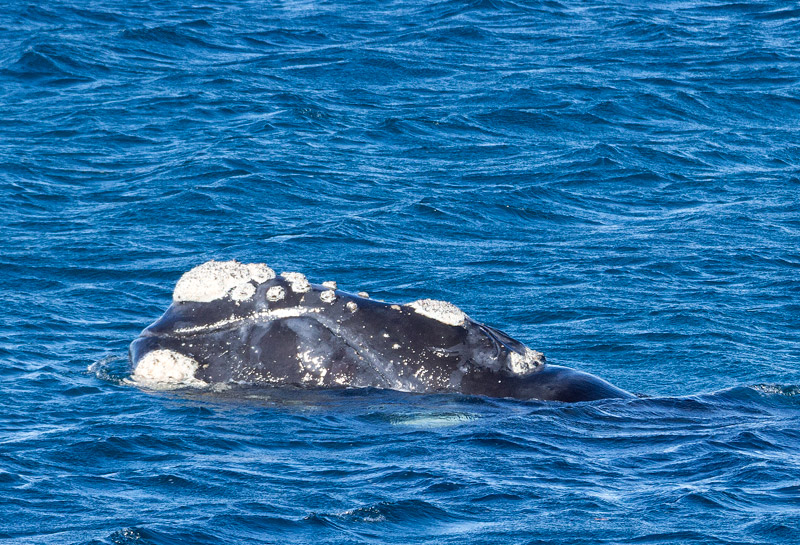
Their have large heads compared to body size with a strongly arched the jaw line. The large mouth has between 205-270 baleen plates that are dark in colour, very fine and long (up to 2.2 metres) in comparison with other species. A very distinctive feature of the head are whitish roughened patches of keratinised skin on the rostrum, chin and lower jaw called Callosities. These are colonised by small crustaceans known as ‘whale lice’. The whales are born with these Callosities and they remain with them for life allowing scientists to identified individual whales.
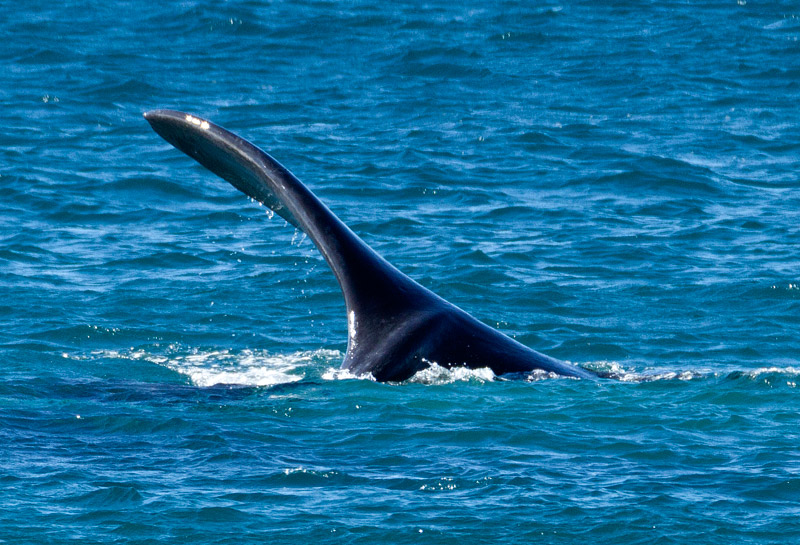
Distribution and Movement Patterns
Like other whale species seen off the Australian coast Southern Right Whales spend the summer months deep in their feeding grounds deep in the Southern Ocean. During the winter months they come north to breed along the southern coastlines, particularly in Western Australia and South Australia.
Australia – Southern Right Whales are seen off the southern coastlines of Australia during the winter months (April – November) each year. They have been recorded in the coastal waters of all Australian states with the exception of the Northern Territory.
Whilst Southern Right’s have a broad geographic range across Australian waters they tend concentrates along the southern coastlines of Western Australia and South Australia where their major breeding grounds are found. Principle breeding grounds are located at Western Australia’s Doubtful Island Bay and east of Israelite Bay, in South Australia at the Head of Bight on the Nullabor. Smaller numbers of calving females are regularly seen in Western Australia at Twilight Cove, Flinders Bay, the Albany/Cape Riche area, and the Yokinup Bay/Cape Arid area; in South Australia Encounter and Fowlers Bay’s; and off Warrnambool in Victoria. They may also occasionally use a number of locations on the Western Australian coast west of Israelite Bay between more regular calving grounds, Sleaford Bay in South Australia, Port Fairy and Portland in Victoria, Eden in NSW, and Maria Island and Bruny Island in Tasmania. The distribution of Southern Right Whales away from the Australian coast is unknown.
After white settlement of Australia Southern Right Whales were decimated by whaling on an industrial scale. Current sightings together with historic whaling records suggest that whilst the range of Southern Right Whales in coastal waters is little changed they may not visit calving grounds of great importance as regally. An example of this is the Derwent River Estuary in Tasmania where Southern Right Whales are now rarely seen yet by all historical accounts was an important pre-whaling habitat.
Global – Major populations of Southern Right Whales are found in the southern coastal waters of Australia and South Africa, and South America during the winter months. Smaller populations are found around New Zealand’s sub-Antarctic Auckland and Campbell Islands and around Tristan da Cuhna and Gough Island in the South Atlantic.
It is presumed that southern hemisphere feeding grounds are to the south of the land masses that the whales migrate to, this is mostly inferred from historic whaling records along with some contemporary sightings. The location of these feeding grounds is likely to be highly dependent on how any climate, oceanic and ecosystem processes affect the location and abundance of their prey.
Incomplete DNA studies of the southern hemisphere Southern Right Whale populations have led scientist to the tentative conclusion that at least four biologically distinct populations exist, wintering off the coasts of Australia, South Africa, Argentina and sub-Antarctic New Zealand. Australian whales may be further differentiated into western and eastern populations. As the breeding areas of these four major populations are geographically separate there is little evidence intermingling apart from the some between the Australian and sub-Antarctic New Zealand populations due to their physical closeness. The degree of geographic overlap of feeding areas and any inter-mixing of the Australian populations with others there is unknown.
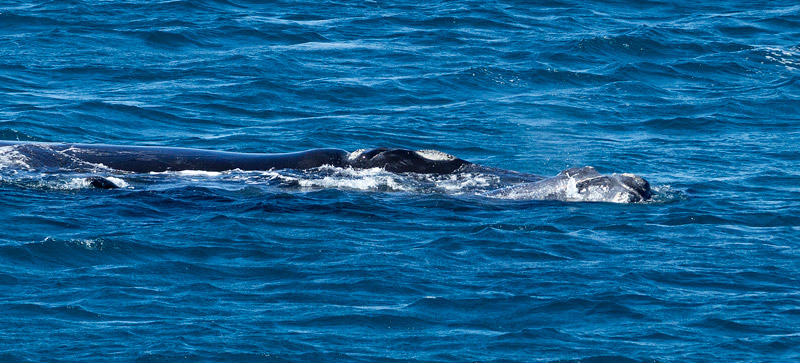
Migration – Southern Right Whales migrates seasonally between Southern Ocean feeding grounds and their breeding grounds along the southern Australian coast during the winter months (May – November). The general timing of migration, when the whales arrive and depart varies from year to year with the specific triggers for migrations remaining unknown. The distances the whales travel are vast with movements between the Australian and New Zealand calving grounds even being documented.
How fast the whales swim whilst migrating remains unknown. Swimming speed near shore are generally slow with coastal movements indicating they travel at between 1 to 3.7 km/hr. Female-calf pairs leaving the Head of Bight calving ground maintained speeds of 2.7 to 4.2 km/hr over 24 hours. Over short distances Southern Right Whales have been know to reach over 15 km/hr.
The migrations routes are not well known but it has been suggested that they follow a circular, anticlockwise migration pattern south of the Australian continent based go historic whaling activity. It is also thought that individual whales approach the coast directly rather than following a consistent widely used near-shore migratory pathway. By using photo-identification catalogues whales movements along the coast can be tracked showing that Southern Right Whales undertake long journeys and use widely separated areas during the same season.
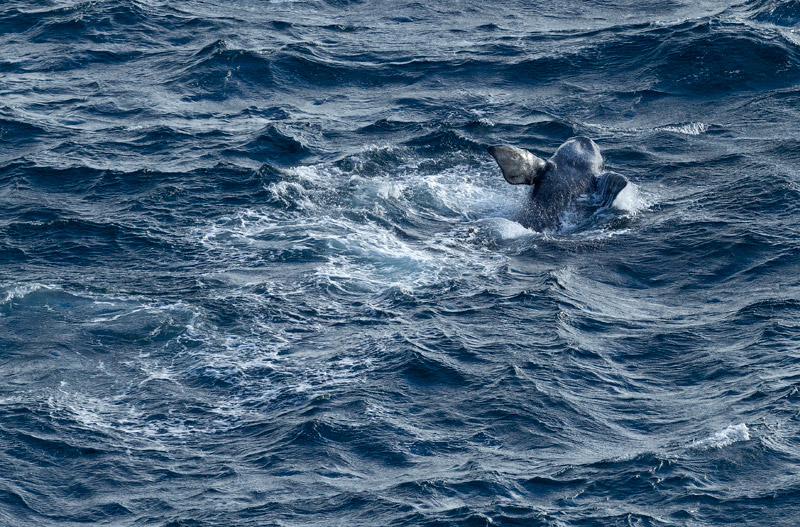
Habitat
Feeding Habitat – It is thought that the Southern Right Whale feeding grounds are in deep offshore waters from sub-Antarctic areas to locations south of 60° S where climatic and environmental conditions generating high productivity. Given these remote locations no dedicated studies have been undertaken.
Breeding Habitat – Southern Right Whales prefer to breed in shallow waters, close to shore and in close proximity to other whales. In the breeding grounds non-calving whales are highly social whilst calving whales tend to distance themselves from these rowdy groups. Individual Southern Right Whale are known to return to the same breeding ground each year suggesting they may have migratory traditions attached to a particular site. This may play a factor in why whales have been very slow to recolonise old disused breeding grounds where whaling wiped out the resident whales.
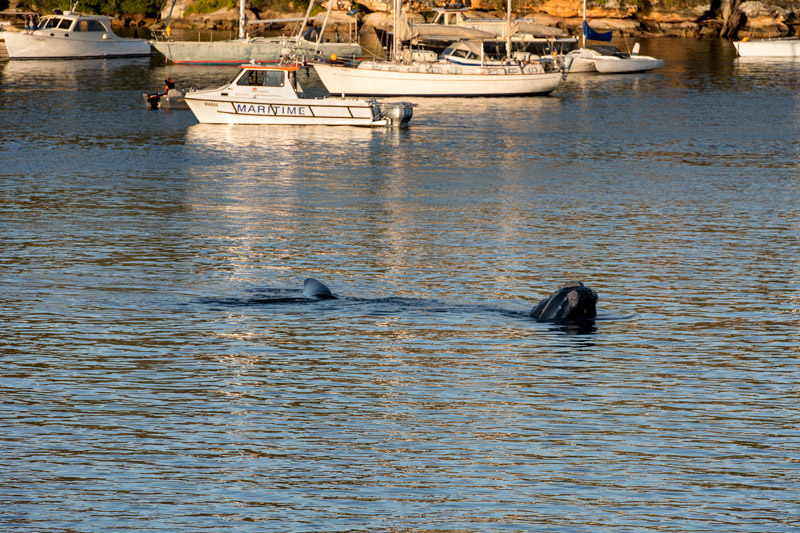
Behaviour
Southern Right Whales like all Right Whales are active on the water surface and are often seen partaking in acrobatic activities. They wave their flippers above the surface, breach, flipper-slap and lobtail. They are very curious loving nothing more than exploring shallow bays, estuaries and beaches. It is not uncommon to see them at the back of a surf break. Human seem to fascinate them and they will approach boats and people in the water such as surfers. They are often seen interacting with other whales particularly Humpbacks and dolphins. Southern Right Whales appear to be the most active and tend to interact with humans more than the other two northern species.
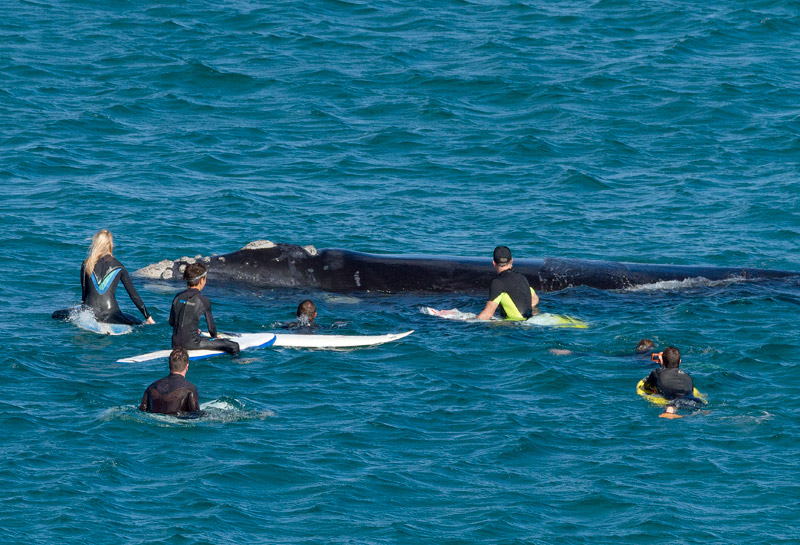
One behaviour unique to Southern Right Whales is ‘tail sailing’ where the whale elevates its tail flukes out of the water to catch the wind although this behaviour has been seen more with the South American whales than in Australia.
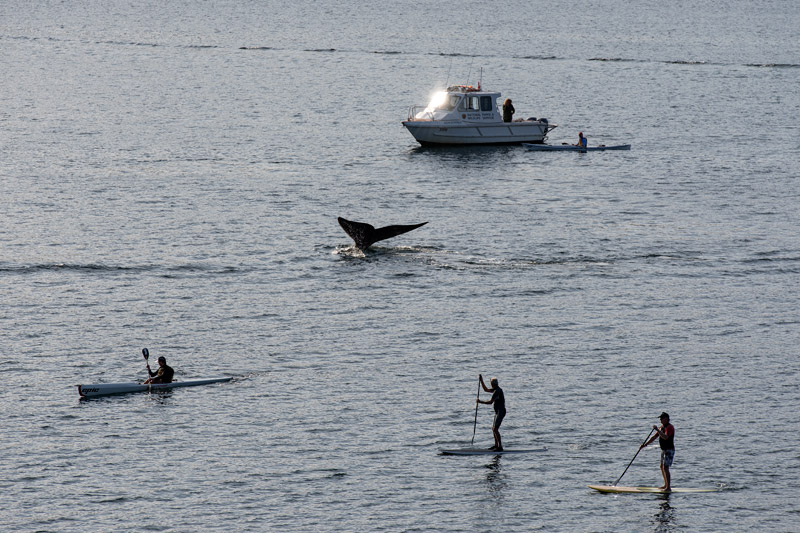
Southern Right Whales seem to have very strong maternal connections with locations where they were born. Females are known to come back to their ‘birth spots’ every three or so years to breed and males may follow patterned migration routes to return to their place of birth as well. Southern Right have been known to nurse unrelated orphans on occasions with several cases of this occurring in South Africa recently.
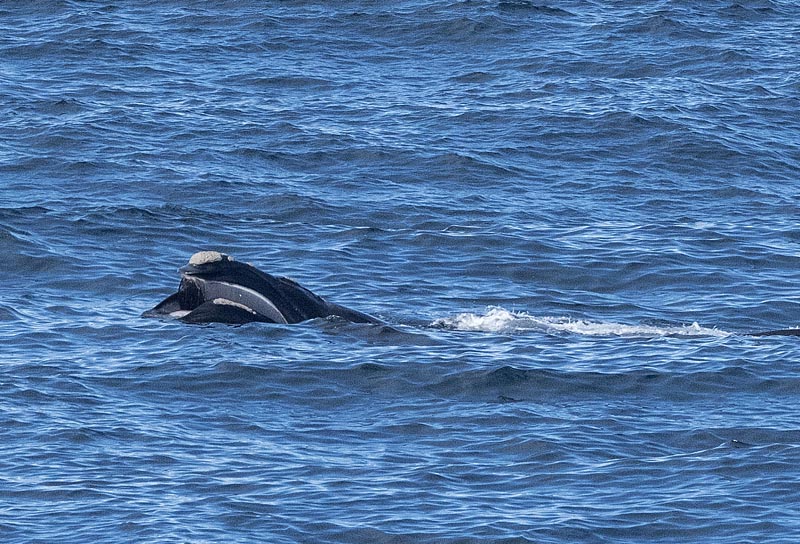
Feeding
Knowledge of what Southern Right Whales eat has tragically come from data collected during illegal whaling in the Southern Ocean during the 1950s to the1970s. Depending on the location Southern Right Whales eat small crustaceans (euphausids, copepods and amphipod crustaceans) north of 40° S and Krill when they move south of 50° S.
As with other whale species such as the Humpbacks the main feeding time is during the summer months into autumn. This is extended into spring and late autumn as opportunity allows. The winter breeding grounds don’t usually provide much in the way of food but whales have been opportunistically feeding when the opportunity presents itself.
The feeding grounds of the Southern Right Whale are generally thought to be in deeper offshore waters between about 32° S and 65° S. Feeding areas may also coincide with oceanographic fronts where prey is concentrated.
How Right Whales feed has been gained by observing Northern Right Whales who have been seen skim feeding; travelling along the waters surface with their mouths open so prey is caught in their baleen. Foraging dives are more associated with the distribution and concentration of preys concentration and location within the water column but appear to be relatively shallow in comparison to some other whales.
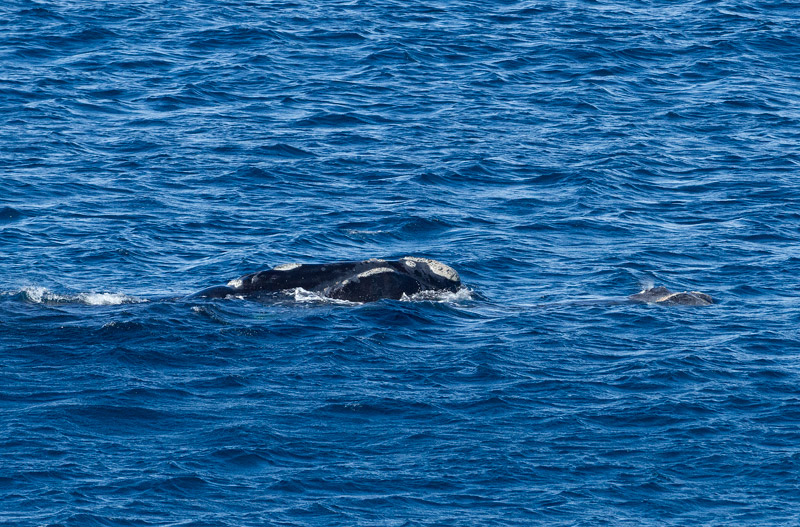
Life Cycle
Southern Right Whale are born after a year long gestation. The newborn will be weaned after another year and with stay with its mother for some time after that. Adult females will breed every 3 to 4 years. It is thought that females will become sexually mature at 5 to 6 year of age with first reproduction taking place after their are 8 years old and when they have reached over 13 metres in length. It is unknown when males become sexually mature.
The life expectancy of Southern Right Whale is unknown but it is thought they live to at least 50 years of age, if not much longer. The closely related Bowhead Whale (Balaena mysticetus) are know to live to over 150 years. Natural mortality amongst adult whales is unknown but thought to be low. Being such a large animal they have few natural predators apart from Killer Whales and sharks who might attack calves, juveniles, or sick adult whales. Adult Southern Right’s are not known to strand.
During the winter months (mid-July through August) the whale migrate to their breeding grounds such as Head of Bight, in South Australia, where calving and mating occurs. Mating often involves large groups involved in energetic surface activities as males jostling one another to get next to the female. This behaviour and the very large size of Southern Right Whale testes have led scientists to propose that polygamous mating in which sperm competition plays a significant role are at play.
The whales have shown a very strong tendency to come back to the same breeding grounds each season, particularly the females. While the vast majority of whales do this some whales will undertake long distance journeys during the season. Whales have even been observed travelling between the breeding grounds of two separate populations.
Gestation lengths have been calculated from observations at the Head of Bight breeding ground at approximately 355 days for Australian Southern Right Whale. South African Southern Right Whales are thought to have a gestation of between 357 and 396 days. Breeding females are rarely seen in the breeding grounds in the year before they give birth which may indicate they are only present in breeding grounds for a short period to get pregnant or that mating occurs in offshore waters? Observations of single females whales in the breeding areas who are then observed with a neonate calf indicate that birthing occurs close to shore. Although some females are occasionally observed with yearlings, photo-identification studies show that calves are usually weaned within 12 months.
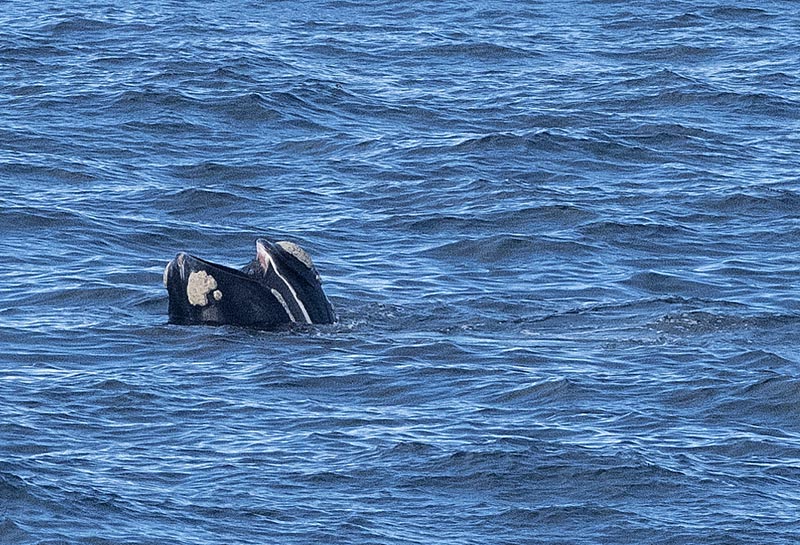
Threats
Like all marine mammals Southern Right Whales have a number of natural and man made threats. Tragically the biggest treat to them is mankind and our activities such as whaling, pollution and climate change.
Natural – Given they’re large size adult Southern Right Whales have few natural predators. Young and sick whales may be attached by Killer Whales and sharks.
Man Made – Pollution, climate change, acoustic disturbance, ship strikes, entanglement and bycatch, over-harvesting of food sources such as Krill stocks and habitat destruction.
The “Right” Whale to Catch – Tragically the Right Whales curiosity, love of bays and shallow water, slow swimming and large quantity of blubber made them the best or ‘right’ whale to catch.
Commercial whaling began in Australia in the 1820’s. The first to go were the mums and calfs who swam into the bays where they were an easy catch for the whalers. By 1845 75% of the Southern Right population had been wiped out. There were so few whales left that the whaling industry collapsed. Sadly it wasn’t until 1935 that they were officially protected. It is currently estimated that that there are approximately 12,000 southern right whales left throughout the southern hemisphere from an original population in in excess of 100,000 (source NSW Parks and Wildlife Service).
References/Sources
Australian Department of the Environment, Canberra
NSW Department of the Environment
QLD Department of the Environment
NZ Department of the Environment
Whales, Dolphins and Porpoises by Mark Carwardine
Whales, Dolphins & Seals: A Field Guide to the Marine Mammals of the World by Hadoram Shirihai and Brett Jarrett
Copyright 2020 David Jenkins – Whale Spotter
